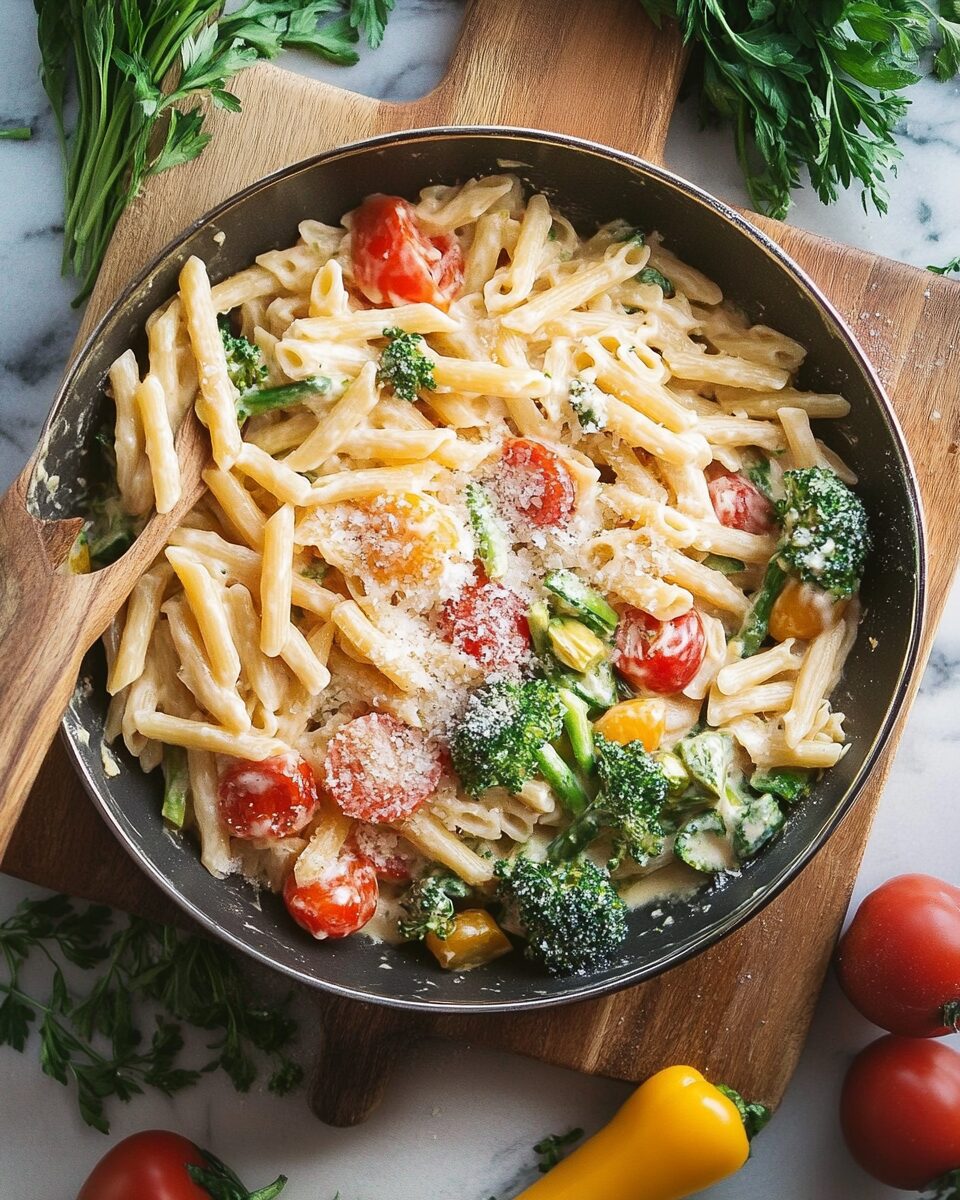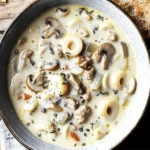The beauty of Pasta Primavera lies in its simplicity. It’s a celebration of seasonal vegetables and comforting pasta, tossed in a creamy garlic-Parmesan sauce that clings perfectly to every bite. This dish is not only nourishing but also incredibly colorful, making it a visual and flavorful standout.
Whether you’re prepping a quick weeknight dinner or planning a no-fuss weekend meal, this vibrant veggie pasta brings freshness and flavor to the table. It’s versatile, easy to make, and a guaranteed crowd-pleaser, even for picky eaters who’ll love the cheesy, creamy goodness!
Full Recipe:
Ingredients:
-
12 oz penne pasta
-
1 tbsp olive oil
-
1 tbsp butter
-
1 cup broccoli florets
-
1 cup zucchini, sliced
-
1 red bell pepper, sliced
-
1 yellow squash, sliced
-
1/2 cup cherry tomatoes, halved
-
2 cloves garlic, minced
-
1/2 cup grated Parmesan cheese
-
1/4 cup heavy cream
-
1/2 cup pasta water (reserved)
-
1/2 tsp Italian seasoning
-
Salt and black pepper to taste
-
Fresh basil for garnish
Directions:
-
Cook pasta according to package directions until al dente. Reserve 1/2 cup of pasta water, then drain and set aside.
-
Heat olive oil and butter in a large skillet over medium heat.
-
Add broccoli, zucchini, squash, and bell pepper. Sauté for 4-5 minutes until slightly tender.
-
Add cherry tomatoes and garlic. Cook for 2 minutes until garlic is fragrant.
-
Reduce heat to low, add cooked pasta, Parmesan cheese, cream, and reserved pasta water. Stir until a creamy sauce forms.
-
Season with Italian seasoning, salt, and pepper. Toss to coat everything evenly.
-
Remove from heat and garnish with fresh basil. Serve warm.
Prep Time: 10 minutes | Cooking Time: 15 minutes | Total Time: 25 minutes
Kcal: 385 kcal | Servings: 4 servings
Pasta Primavera: A Celebration of Seasonal Vegetables and Comfort Food
Pasta Primavera is more than just a dish it’s a delightful culinary expression of the beauty of seasonal vegetables combined with the comforting familiarity of pasta. With its roots in Italian-American cuisine, this colorful, fresh, and flavorful pasta has become a staple for many home cooks seeking something both wholesome and satisfying. The name “Primavera” itself means “spring” in Italian, and fittingly, this dish is a perfect homage to the crisp, bright, and tender vegetables that often flourish in the spring and summer months.
Unlike heavier pasta dishes laden with rich cream or meat-based sauces, Pasta Primavera stands out for its light, refreshing, and nutrient dense profile. It’s a recipe that proves healthy eating doesn’t mean sacrificing flavor. When made properly, each bite bursts with the vibrant essence of garden-fresh vegetables, coated gently in a delicate sauce, and wrapped in perfectly cooked pasta.
The Origins of Pasta Primavera
Despite its Italian name, Pasta Primavera is actually an American creation with a somewhat debated origin story. The most widely accepted version traces it back to the 1970s, when it was popularized by Sirio Maccioni, the legendary restaurateur behind Le Cirque in New York City. Maccioni and his team were reportedly experimenting with a pasta dish that incorporated fresh vegetables while vacationing in Canada. When it made its way to the menu at Le Cirque, it quickly became a hit and later spread like wildfire across restaurants and home kitchens alike.
Since then, Pasta Primavera has evolved from a trendy New York invention to a beloved classic in homes around the world. The original dish was heavier, using cream and cheese to balance the vegetables, but contemporary versions, like the one we’re focusing on here, favor a lighter approach using olive oil, garlic, fresh herbs, and a bit of lemon for brightness.
Why Pasta Primavera Works So Well
There are a few reasons why this dish continues to be so popular among food lovers:
1. It’s Incredibly Versatile:
One of the biggest strengths of Pasta Primavera is its adaptability. While traditionally made with spring vegetables like zucchini, bell peppers, cherry tomatoes, and asparagus, you can easily adjust the mix depending on what’s in season or what you already have on hand. In the summer, you might opt for fresh corn and peas. In the fall, roasted squash or mushrooms could take center stage.
2. It Balances Flavor and Nutrition:
Fresh vegetables not only add color and texture to the dish but also pack it with vitamins, fiber, and antioxidants. When you lightly sauté them, their natural flavors intensify, adding layers of sweetness, crunch, and earthiness that balance beautifully with pasta. Olive oil, garlic, and fresh herbs elevate the flavor without overwhelming the natural taste of the vegetables.
3. It Can Be Made Vegan or Gluten-Free:
If you’re catering to dietary needs, Pasta Primavera is very accommodating. Use gluten free pasta for those with gluten intolerance, or swap in a plant-based Parmesan or nutritional yeast to make it vegan. You can also add grilled chicken, shrimp, or tofu for extra protein if desired.
4. It’s Visually Appealing:
Few dishes look as naturally stunning on the plate as Pasta Primavera. The mix of colorful vegetables and golden pasta makes it a feast for the eyes as well as the palate. It’s a popular choice for dinner parties, potlucks, and family meals alike.
Tips for Making the Perfect Pasta Primavera
To get the most out of this dish, it helps to keep a few things in mind:
-
Choose High-Quality Vegetables: Fresh, seasonal produce will make a world of difference. Look for vibrant colors, firm textures, and peak ripeness.
-
Don’t Overcook the Veggies: Part of the charm of Pasta Primavera is the slight crunch of just-cooked vegetables. Overcooked veggies can become mushy and lose their vibrant appeal.
-
Cook Pasta Al Dente: This gives the pasta a bit of bite and prevents it from becoming too soft when mixed with the warm vegetables and sauce.
-
Reserve Some Pasta Water: That starchy pasta water can be used to loosen the sauce and help everything cling to the noodles beautifully.
-
Garnish with Fresh Herbs and Cheese: A final touch of grated Parmesan or Pecorino Romano and a sprinkle of chopped fresh basil or parsley can really bring the dish together.
What to Serve With Pasta Primavera
While Pasta Primavera is easily a standalone meal, it pairs wonderfully with a variety of sides. A simple arugula or mixed green salad with lemon vinaigrette is a great way to start. For those who want a heartier meal, serve it with a slice of crusty bread or garlic toast. And of course, a glass of chilled white wine like Pinot Grigio or Sauvignon Blanc can be the perfect companion.
If you’re serving Pasta Primavera at a dinner party or family gathering, consider finishing the meal with a light dessert, such as lemon sorbet, panna cotta, or fresh berries with whipped cream. It keeps the meal fresh and balanced from start to finish.
Making It Your Own
Because Pasta Primavera is so flexible, it’s a fantastic dish for experimenting in the kitchen. Want a little spice? Add red pepper flakes. Prefer roasted veggies? Roast them first for deeper flavor. Craving some umami? Toss in some sun-dried tomatoes or a splash of balsamic glaze.
Some cooks even blend a portion of the sautéed veggies with a bit of the pasta water to create a smoother, veggie-based sauce. Others opt to roast all the vegetables and then toss them with hot pasta for a more rustic flavor. The possibilities are endless and that’s what makes this dish truly timeless.
Conclusion
Pasta Primavera is a celebration of fresh ingredients, simple cooking, and the joy of eating vibrant, wholesome food. Whether you’re a seasoned cook or just starting your culinary journey, this dish offers a canvas for creativity while remaining grounded in simplicity and flavor. It’s a meal that nourishes the body and uplifts the spirit, reminding us that sometimes the best dishes are those that let the ingredients shine.
It’s not just a recipe it’s a reminder to eat seasonally, cook joyfully, and appreciate the beauty in fresh, simple meals. Add this to your weekly dinner rotation, your next dinner party menu, or your list of go-to comfort meals you won’t regret it.





